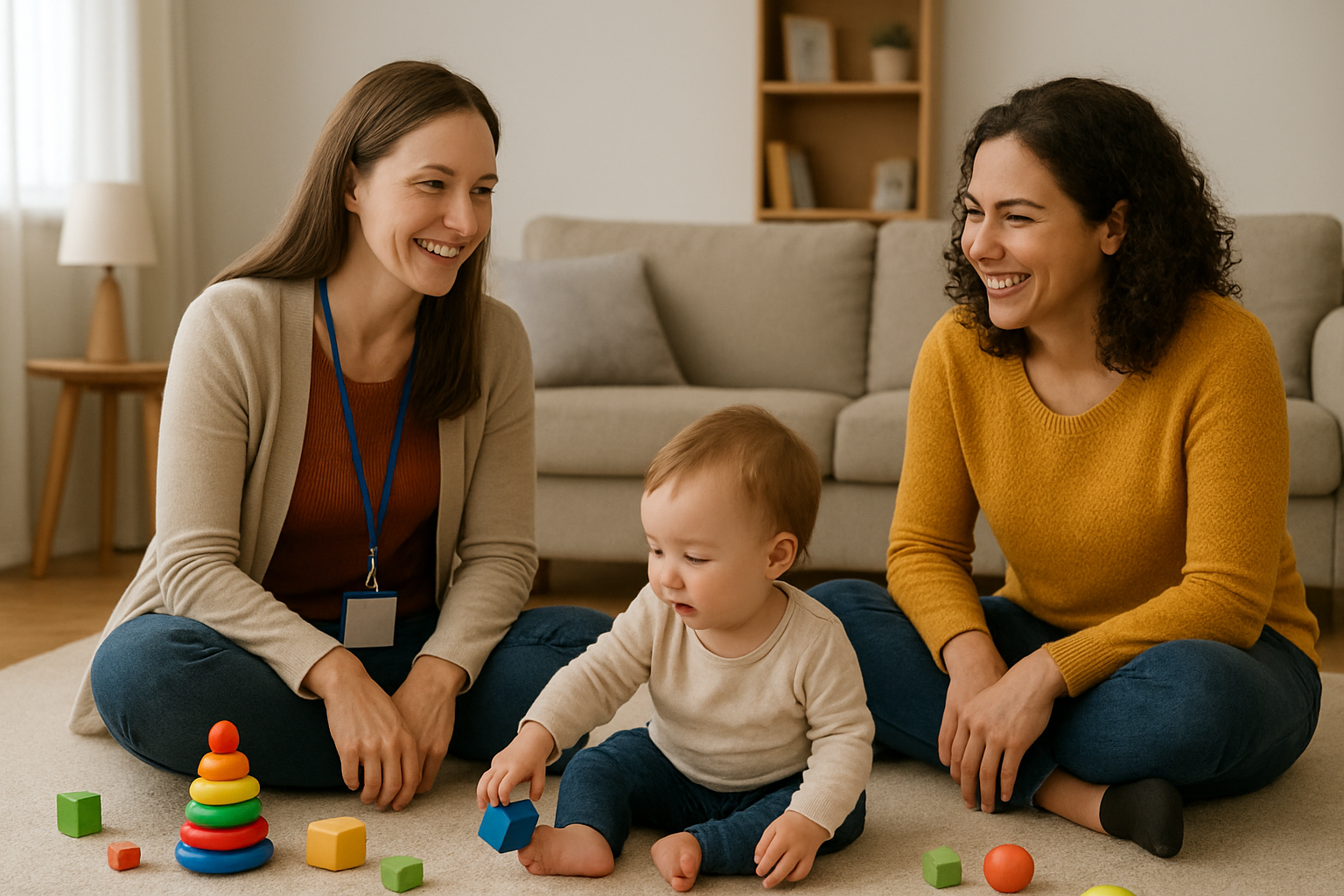Not every child that has speech sound errors needs support from a Speech and Language Therapist. Sometimes a bit of practice with parents and caregivers at home or school is enough to place a child on the path to clear speech. If your child has speech sound errors, try these tips for teaching specific speech sounds.
| Speech Sound | Lips and Tongue Placement | Additional Clues |
| b | Start with lips together and make them pop while turning on your voice. | There should be a quick vibration in your throat when your voice comes on. |
| p | Start with lips together and make them pop while blowing. Keep your voice off. | If your child says ‘b’ instead of ‘p,’ have them whisper the sound. |
| m | Show your child how to close their lips tightly together and hum to say ‘m.’ | Your lips and throat should vibrate. |
| sh | Form you lips into a square and put your tongue tip at the top of your mouth, behind your front teeth while blowing. | You can call this the quiet sound and help your child remember lip position by holding your finger up near your mouth while saying “shhh” as if to quiet someone. |
| zh (as in camouflage) | Form you lips into a square and put your tongue tip at the top of your mouth, behind your front teeth while humming. | Your mouth and throat should vibrate when saying ‘zh.’ |
| ch | A ‘ch’ is produced by saying ‘t’ and ‘sh’ quickly together. Start by establishing a good ‘sh’ sound. Once your child can consistently say “sh,” ask your child to push their tongue flat on the roof of their mouth behind their front teeth (like a ‘t’) and then explode into a ‘sh.’ | This is the ‘choo-choo train’ sound. When your tongue explodes, that is the train engine making the choo-choo noise. |
| j | A ‘j’ is produced by saying ‘d’ and ‘zh’ quickly together. Start by establishing a good ‘zh’ sound. Once your child can consistently say “zh,” ask your child to push their tongue flat on the roof of their mouth behind their front teeth (like a ‘d’) and then explode into a ‘zh’ while turning on their voice. | There should be a quick vibration in your throat when your voice comes on. |
| w | Start by saying “oo” as in ‘boo’ and then slowly move the lips apart to say “uh”. It should sound like “oooouuuhh.” | If your child is struggling with ‘w,’ have them pretend they are blowing out a candle then turn on their voice while blowing. |
| y | Start by saying “ee” as in ‘bee’ and then slowly open your mouth to say “uh”. It should sound like “eeeeuuuhh.” | If your child is putting a pause between the ‘ee’ and the ‘uh,’ cue them to stretch it out and keep their voice on the whole time. |
| n | Place your tongue tip on the bumps behind the front teeth while humming. | Your mouth and throat should vibrate when saying ‘n.’ |
| v | Ask your child to use their top teeth to gently bite down on their bottom lip then blow air to say ‘v’. | Calling this the ‘noisy rabbit teeth’ sound may help your child remember their teeth placement and voice. Your throat should vibrate when saying ‘v.’ |
| f | Ask your child to use their top teeth to gently bite down on their bottom lip then hum to say ‘f’. | Calling this the ‘quiet rabbit teeth’ sound may help your child remember their teeth placement for ‘f.’ |
| th | Have your child place their tongue between their teeth (with their tongue sticking slightly out of their mouth) and gently bite down while blowing air. | Looking in a mirror can be helpful for tongue placement when learning ‘th.’ |
| L | Ask your child to put their tongue tip to the top of their mouth on the bumps behind their front teeth and turn on their voice. | Use a mirror to show your child correct tongue placement if they are flipping or curling their tongue. Try the ‘sticky spot’ trick for learning to say ‘t’ if your child can’t find where to put their tongue when saying ‘L.’ |
| d | To produce the ‘d’ sound, your tongue taps behind your front teeth while turning on your voice. | There should be a quick vibration in your throat when your voice comes on. Try the ‘sticky spot’ trick for learning to say ‘t’ if tongue placement for ‘d’ is an issue. |
| t | To produce the ‘t’ sound, your tongue taps behind your front teeth while blowing air. Keep your voice off. | If your child is struggling to find the correct spot to place their tongue to say ‘t,’ put a sticky food, like peanut butter, on the spot right behind their top, front teeth. Then, have your child lick it off. When you are describing that spot again, call it the ‘sticky spot.’ |
| h | ‘h’ is produced by making puffs of air at the back of the mouth. Open your mouth and pant. | You can call this the ‘doggie’ sound and practice panting like a dog to make a ‘h.’ Your child should be able to feel air coming out of their mouth while making a ‘h.’ |
| z | Place your tongue tip to the top of the mouth on the bumps behind your front teeth while humming. | Your mouth and throat should vibrate while saying ‘z.’ If the sound is not quite right, try having your child open their lips into a very slight smile while humming. |
| s | Place your tongue tip to the top of the mouth on the bumps behind your front teeth while blowing. | This is the ‘smiling snake’ sound. You lips should open into a slight smile when saying ‘s.’ |
| r | ‘r’ is produced with the sides of your tongue touching your back molars and your tongue pulled back slightly so it is bunched in the back of your mouth. Finally make a small square with your lips and push air past your tongue while turning on your voice. | When learning the tongue position for ‘r,’ some children find it easier to start with the ‘r’ blends ‘cr’ and ‘gr’ (as in crook and green). |
| g | Tap the back of your tongue to the roof of your mouth and turn on your voice when saying ‘g.’ | This is the ‘swallowing or gulping’ sound. You can pretend you are noisely driking a glass of water while practicing the ‘g’ sound. Your throat should vibrate when saying ‘g.’ |
| k | Tap the back of your tongue to the roof of your mouth when saying ‘k.’ Keep your voice off. | If your child is struggling to find the back of their tongue, have them look directly up while tapping their tongue at the back of their mouth. |
If your child is not progressing after practicing speech sounds with you at home or their
sound errors are making it difficult for them to learn phonics and early literacy skills, your child may need support from a speech and language therapist. Furthermore, if they have delayed speech sound development, persisting phonological processes, and/or their intelligibility rating 1 is lower than expected for their age, specialist advice from a speech and language therapist should be sought.
If you would like more information about speech sound development in children or speech therapy with South Lakes Speech & Language Therapy, please get in touch. Follow us on Facebook for more speech, language and feeding tips and sign up for South Lakes Speech & Language Therapy’s newsletter if you would like new posts sent directly to your inbox.
- Speech Intelligibility Rating by age:
18 months old – 25% intelligible
24 months old – 50% intelligible
3 years old – 75% intelligible
4 to 5 years old – 100% intelligible ↩︎










